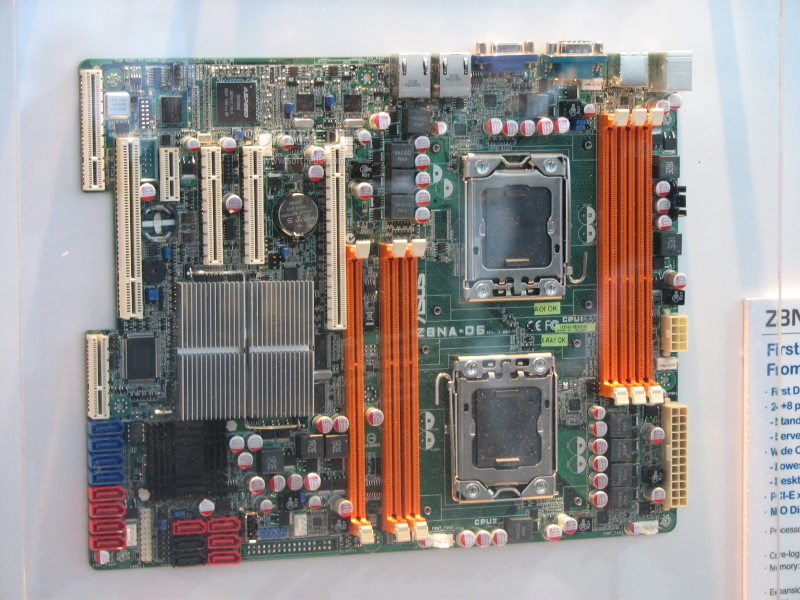Asus Shows Off Dual Socket 1366 Motherboard
Asus is shaking things up in the netbook world, but it hasn't forgotten about the enthusiast crowd.
During CeBIT Germany today, the Taiwanese computer giant showed off its newest motherboard. Dubbed the Z8NA-D6, this newest mainboard will allow for two LGA1366 processors to be used in the same system.
Asus also claims that at 12-inches by 9.6-inches, the Z8NA-D6 is the world's first dual socket ATX motherboard, which allows for it to be used in virtually any ATX computer case (note: Intel's Skulltrail is an Extended ATX mobo). The power connector is another point of interest. The 24+8 pin connection allows for both ATX and SSI power supplies to be used, the latter of which is traditionally used in servers.
The motherboard is based on Intel's 5500+ICH10R chipset, and can support all 1366 processors, including the upcoming Xeon 5500s. Supported memory includes up to 48 GB of RDIMM or 24 GB of UDIMM, with ECC support. The one shortcoming of this board is the lack of PCIe 2.0 x16 slots. With only one on the Z8NA-D6, you can forget about any sort of SLI or Crossfire setup. As for other expansion slots, the Z8NA-D6 comes with two PCIe x8 slots, one PIKE slot, and a PCIe x1 slot, which will likely be used for a soundcard. Like any other Asus mobo, expect this one to come with RAID software already included on the board.
The Z8NA-D6 may be the first dual socket 1366 motherboard spotted (no price or release date yet), but we doubt it's the last. 1366 Skulltrail, anybody?
Get Tom's Hardware's best news and in-depth reviews, straight to your inbox.
-
AndyYankee17 raid software included on the board? don't you mean raid hardware? for anybody that uses raid that's a big differenceReply -
ravenware Be interesting to see how it performs in games and other apps, maybe games have evolved?Reply
The Skull trail and quadFX setups from the past were not very impressive. -
AndyYankee17 wow, just realized this, 16 virtual CPUs, that keep rendering and encoding apps happy, albeit for a very time lolReply -
Gazz But you still only have 6 ram slotsReply
What happened to the 8 or 12 you have two cpu's you should have doubble the ram slots only half baked if you ask me
-
dconnors GazzBut you still only have 6 ram slotsWhat happened to the 8 or 12 you have two cpu's you should have doubble the ram slots only half baked if you ask meReply
My bet is that they went with six RAM slots due to space constraints. There isn't exactly a lot open real estate on that board. Besides, 24 GB over six slots is more than enough for anything, as evidenced by our VM story yesterday: http://www.tomshardware.com/news/kingston-core-i7-crysis,7194.html
-Devin -
Pei-chen At least it will be cheaper than the $16,000 AMD rendering machine featured recently. I bet it is cooler too.Reply -
AndyYankee17 eddieroolzThe lack of a second PCIe hurts it as a gaming platform though..makes it nice for 3d animation as those cards (fireGL, and the nvidea equivalent, forget what it's called) don't used sli/crossfire. meaning you can use the other slots for raid controller cards and other workstation type thingsReply
